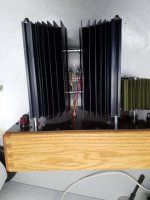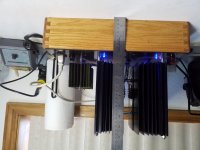no change in sound
What was the reasons for these changes at all? Usually any change is made with a reason, I try to understand what these reasons are.. Thanx! 😉
Some changes were to add features, like the pot for 2nd harmonic trim, changes in
semiconductors by way of lowering distortion and the attendant compensations that
came with them, and some are just arbitrary.
semiconductors by way of lowering distortion and the attendant compensations that
came with them, and some are just arbitrary.
Does this mean, that if I plan to use 2sj74/2sk140 than i should go with the v3 instead of the original? Or if i go with v1 schematic and use 74/140, should i change the input 4,75/47,5k to 1/100k combo? Or am I completely wrong?
Last edited:
go with V3 , whichever JFets you have
if you don't have THD Spectra measurement setup , just position P3 in mid position , prior to soldering , simply using ohmmeter
if you don't have THD Spectra measurement setup , just position P3 in mid position , prior to soldering , simply using ohmmeter
If you don't have a distortion meter there is always the toe tapping meter. Just let your ears decide.
You'll find what you like completely unbiased, to what your brain tells you, you must like. That can sometimes happen using a distortion meter.
You'll find what you like completely unbiased, to what your brain tells you, you must like. That can sometimes happen using a distortion meter.
I have often wondered if the optimum setting might be one channel 3rd harmonic dominant and the other channel 2nd harmonic dominant.
No joke.
Never tried it, but will try one day.
No joke.
Never tried it, but will try one day.
it's simple
go to drugstore and buy just one earplug
change plugged ear side whenever you want

go to drugstore and buy just one earplug
change plugged ear side whenever you want

Flamethrower1, did the 3U come with any holes drilled or did you need to drill and tap?
No, it did not.
I drilled and tapped my holes.
Took some time, worth it though, saved some money and it was fun.
Ok, not fun, well worth the effort though
No, it did not.
I drilled and tapped my holes.
Took some time, worth it though, saved some money and it was fun.
Ok, not fun, well worth the effort though
Flammethrower1
Yeah I kinda thought that might be the case but drilling and threading isn't
that bad. Thanks
I've got a question....
I've got an F5 here and I'm fixin to break it down into monoblocks using another 4U chassis from the diyaudiostore. Each FET will get it's own heatsink. PLENTY of cooling action.... I'm thinking of raising the bias from about 1.4 amp to maybe 1.5. What I'm wondering is, given the much larger cooling solution on each MOSFET, can I get away lowering the source resistor values from .47R to maybe half that? Will that size heatsink give me the stability to pull that off?
I've got an F5 here and I'm fixin to break it down into monoblocks using another 4U chassis from the diyaudiostore. Each FET will get it's own heatsink. PLENTY of cooling action.... I'm thinking of raising the bias from about 1.4 amp to maybe 1.5. What I'm wondering is, given the much larger cooling solution on each MOSFET, can I get away lowering the source resistor values from .47R to maybe half that? Will that size heatsink give me the stability to pull that off?
I've got a question....
I've got an F5 here and I'm fixin to break it down into monoblocks using another 4U chassis from the diyaudiostore. Each FET will get it's own heatsink. PLENTY of cooling action.... I'm thinking of raising the bias from about 1.4 amp to maybe 1.5. What I'm wondering is, given the much larger cooling solution on each MOSFET, can I get away lowering the source resistor values from .47R to maybe half that? Will that size heatsink give me the stability to pull that off?
I reckon you'd be better off going turbo V1 with that chassis and basis... Just my 2C (undithered).
I reckon you'd be better off going turbo V1 with that chassis and basis... Just my 2C (undithered).
Well, that's not what's gonna happen. I've already got 32V rails going and I have no earthly need for that kind of power. Just looking for some opinions on reducing the source resistance.
Well, that's not what's gonna happen. I've already got 32V rails going and I have no earthly need for that kind of power. Just looking for some opinions on reducing the source resistance.
Parallel output devices essentially halves the source resistance... Also multiple devices spreads the dissipation better over the heatsink and improves reliability. It's not so much about extra power with the V1, but maybe for some reason you don't want to do it, ok...
With a single pair of output devices, you've got no current hogging issues. I would think you could get away with dropping the source resistors entirely.
To optimise it for your speakers though you'd want to balance the current delivery with your rail voltage. If your speakers are nominally 8ohms that probably means something on the order of 0R33 for your 32V rails -- although my brain is math challenged so I'd want to sim it first....
To optimise it for your speakers though you'd want to balance the current delivery with your rail voltage. If your speakers are nominally 8ohms that probably means something on the order of 0R33 for your 32V rails -- although my brain is math challenged so I'd want to sim it first....
I did some sims: 0R27 seems to work nicely with a bias around 2.4A. That's into 8 ohms; you'd want more current into 6 or 4.
That's working those MOSFETs pretty hard, so you'd likely be replacing them more often. But I haven't the foggiest if that reduces their average lifetime from something like 20 years to 8 years, or more like 20 years to 8 months.
That's working those MOSFETs pretty hard, so you'd likely be replacing them more often. But I haven't the foggiest if that reduces their average lifetime from something like 20 years to 8 years, or more like 20 years to 8 months.
- Home
- Amplifiers
- Pass Labs
- F5 power amplifier


